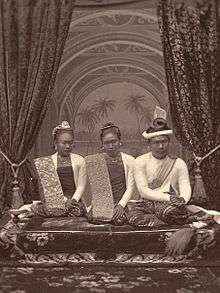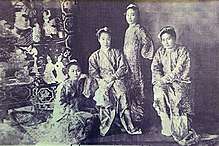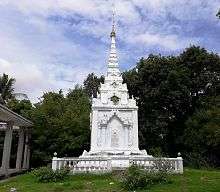Supayalat
Supayalat (Burmese: စုဖုရားလတ်, pronounced [sṵpʰəjá laʔ]; 13 December 1859 – 24 November 1925), also spelt Suphayalat, was the last queen of Burma who reigned in Mandalay (1878–1885), born to King Mindon Min and Queen of Alenandaw (literally Middle Palace, also known as Hsinbyumashin or Lady of the White Elephant). The British corruption of her name was "Soup Plate".[1] She was married to her half-brother, Thibaw, who became the last king of the Konbaung dynasty in 1878, upon Mindon Min's death. She is best known for engineering a massacre of 80 to 100 royal family members, to prevent potential rivals from usurping Thibaw's power,[2] although she had always denied any knowledge of the plot, which may have been hatched by her mother together with some of the ministers, including the chancellor Kinwon Min Gyi U Kaung.[3][4]
| Supayalat စုဖုရားလတ် | |||||
|---|---|---|---|---|---|
 Chief queen Supayalat | |||||
| Chief queen consort of Burma | |||||
| Tenure | 12 April 1879 – 29 November 1885 | ||||
| Predecessor | Supayagyi | ||||
| Successor | disestablished | ||||
| Queen of the Northern Palace | |||||
| Tenure | 18 November 1878 – 12 April 1879 | ||||
| Predecessor | Thiri Maha Yadana Mingala Dewi | ||||
| Successor | none | ||||
| Born | 13 December 1859 Mandalay, Burma | ||||
| Died | 24 November 1925 (aged 65) Rangoon, British Burma | ||||
| Burial | |||||
| Spouse | Thibaw | ||||
| Issue | 1 son, 4 daughters: Myat Phaya Gyi Myat Phaya Lat Myat Phaya Myat Phaya Galay | ||||
| |||||
| House | Konbaung | ||||
| Father | King Mindon | ||||
| Mother | Hsinbyumashin | ||||
| Religion | Theravada Buddhism | ||||
Self-anointed queen

Princess Hteik Supayalat aka Princess of Myadaung, with the official title of Sīri Suriya Prabha Ratanā Devī (သီရိသူရိယပြဘရတနာဒေဝိ), was the second of three daughters born to Mindon and Hsinbyumashin, daughter of Bagyidaw (Mindon's uncle) and Nanmadaw Me Nu born in Pha Lan Gon, and the third of Mindon's four highest-ranking queens. The three other queens of Mindon had no children, and Hsinbyumashin became more powerful after the death of the chief queen Setkya Devi. Thibaw, on the other hand, was the son of a middle-ranking queen, Laungshe Mibaya. He was however learned in the Buddhist scriptures and also educated by the missionary Dr Marks,[5] and became one of Mindon's favourite sons.
In 1878, Thibaw succeeded his father in a bloody succession massacre. Hsinbyumashin, one of Mindon's queens, had grown dominant at the Mandalay court during Mindon's final days. Under the guise that Mindon wanted to bid his children (other princes and princesses) farewell, Hsinbyumashin had all royals of close age (who could potentially be heir to the throne) mercilessly slaughtered by edict, to ensure that Thibaw and her daughter Supayalat would assume the throne.

The ambitious Hsinbyumashin, after putting him on the throne, offered her oldest daughter Hteik Supayagyi, Princess of Mong Nawng to be his queen, but during the royal wedding ceremony Supayalat pushed in next to her sister to be anointed queen at the same time, breaking ancient custom. Her sister's marriage was never consummated, and Supayalat was said to have forced monogamy on a Burmese king for the first and the last time in history, even though Thibaw also subsequently married her youngest sister Hteik Supayalay, Princess of Yamethin.[3] Supayalat was only 19 and Thibaw 20 when they ascended the lion throne (Thihathana palin).
Exile
Their reign lasted just seven years when Thibaw Min was defeated in the Third Anglo-Burmese War and forced to abdicate by the British in 1885. On 25 November 1885 they were taken away in a covered carriage, leaving Mandalay Palace by the southern gate of the walled city along the streets lined by British soldiers and their wailing subjects, to the River Irrawaddy where a steamboat called Thuriya (Sun) awaited. Thibaw was 27 and Supayalat 26.
Supayalat never lost her composure, and was said to have asked a British soldier by the wayside for a light to smoke a Burmese cheroot.[2][6] She was pregnant and accompanied by her husband, their two daughters, her two sisters, and her mother; the rest of their party followed on foot. The troops had nicknamed her "Soup Plate", and in the commotion and haste that attended their abduction, some of the crown jewels disappeared including a large ruby called Nga Mauk that Colonel Sladen had insisted on being handed over for safekeeping.[4][7] Thibaw saw an opportunity in 1911 when King George V visited India, and wrote for the return of the Burmese crown jewels, but only received a reply that Col. Sladen had died in 1890. Nga Mauk was believed to have subsequently turned up as the largest ruby on the British crown; it was recognised by Princess of Kyundaung in whose charge the ruby used to be.[8]

On 10 December 1885 the royal family, minus the queen mother and Supayagyi who were sent to Dawei, was taken to Madras where their third daughter was born, and in April the next year they were moved to Ratnagiri on the west coast where they could no longer look across the Bay of Bengal to the land they had been forced to leave. Supayalat gave birth to her fourth and youngest daughter in 1887; they were not given a proper residence commensurate with their status until 1911 when Thibaw Palace was built by the government. In 1914 the royal princesses had an ear-piercing ceremony (နားသွင်းမင်္ဂလာ nahtwin mingala) according to Burmese custom. Some of the family members, court officials and entertainers including the famous orchestra of Sein Beida and the harpist Deiwa Einda Maung Maung Gyi from Burma were permitted to attend the ceremony. Although Supayalat's first born was a boy he did not survive infancy, and she had also lost another daughter.

The royal princesses were named as follows:
- Hteiksu Myat Phaya Gyi (1880–1947) married an Indian door guard at Thibaw Palace. She have only a daughter named Tu Tu.
- Hteiksu Myat Phaya Lat (1882–1956) married a Burmese courtier at Thibaw Palace; neither of these unions met with the royal parents' approval.
- Hteiksu Myat Phaya Aka Madras Supaya (1886–1962) returned to Burma with her mother, and married a grandson of Mindat Min, her great uncle and brother of King Mindon.
- Hteiksu Myat Phaya Galay (1887–1935), the youngest and brightest, was fluent in English and acted as the royal family's spokesperson airing their grievances in a document called Sadutta thamidaw ayeidawbon sadan (စတုတ္ထသမီးတော်အရေးတော်ပုံစာတမ်း The Fourth Royal Daughter Crisis Document); she was sent away by the colonial government to live in Moulmein where she spent the rest of her days.
Return
Supayagyi, who had remained childless, looked after her four royal nieces, and died in 1912. When King Thibaw died in 1916 at the age of 58 after 30 years in exile, Supayalat fought in vain for the right to take her husband's body back to be buried with proper funeral rites in Burma. She refused to give up the bodies of both her sister and her husband, buried in the grounds of their palace, to the authorities who eventually took them by force to be buried in Ratnagiri in 1919.[4] The queen did not attend the funeral although she did send two of the royal princesses to the ceremony. The tombs of the king and Supayalay were later joined by that of Pahtama thamidaw (First Royal Daughter) who died in 1947.
Supayalat returned to Rangoon in 1919, and was not allowed to return to Mandalay. She had lived on a pension and in her last days her closest adviser was Thakin Kodaw Hmaing, the great writer and nationalist leader, who revered her for her defiant stand against colonialism and who had witnessed at the age of nine the fall of the monarchy and the abduction of the royal couple in Mandalay.[3][9] Hmaing was a boarder at Myadaung Monastery built by the queen who never had the chance to conduct an opening ceremony (yeizetcha, literally "pour drops of water", in order to call on the goddess of earth to witness the good deed) as it had only been recently completed. She had never regarded herself as beholden to the British who she believed robbed her of her kingdom with all the wealth and riches therein.

She died six years later, in 1925, shortly before her 66th birthday. Although the colonial government declared the day of her funeral a national holiday, the royal family's request for her to be buried in Mandalay was also refused. Her funeral was, however, held with pomp and ceremony as befitted a Burmese queen, organised by the Saophas of Yaunghwe and Thibaw. Her body lay in state, shielded under eight white royal umbrellas, attended by 90 Buddhist monks and the British Governor Sir Harcourt Butler with a guard of honour of the Mounted Police complete with a 30 gun salute.
Supayalat lies buried at Kandawmin Garden Mausolea near the Shwedagon Pagoda between the tombs of Aung San Suu Kyi's mother Khin Kyi and the former UN Secretary General U Thant.[9]
Supayalat in literature
- The Lacquer Lady - a novel by F. Tennyson Jesse
- The Glass Palace - a novel by Amitav Ghosh
- The City of Gem - a novel by Joanna Trollope
- Mandalay - a poem by Rudyard Kipling
References
- Marshall, Andrew (2002). The Trouser People: A Story of Burma - In the Shadow of the Empire. p. 43. ISBN 1-58243-120-5.
- Champeon, Kenneth (July 2003). "The Last Queen of Burma". The Irrawaddy. Retrieved 2006-12-08.
- Khin Maung Soe (February 2007). "The Tragic Queen". The Irrawaddy. Retrieved 2007-02-05.
- The Bandoola Journal (February 2007). "A Teatime Tete-à-Tete". The Irrawaddy. Retrieved 2007-02-05.
- Marks, John Ebenezer (1917). Forty Years in Burma. London: Hutchinson & Co. ISBN 0-524-03906-2. Retrieved 2007-03-09.
- Thant Myint U (2001-03-26). The Making of Modern Burma (PDF). Cambridge University Press. p. 1. ISBN 0-521-79914-7.
- Dr. Sein Tu. "Rubies of Myanmar". Archived from the original on 2007-09-27.
- Shwebo Mi Mi Gyi - translated from Burmese. "The Royal Ruby (Padamyar Ngamauk)". Myanmar's Net Inc. Retrieved 2007-03-10.
- Khin Maung Soe (November 2006). "Burma's Tomb Raiders". The Irrawaddy. Retrieved 2007-03-09.
External links
- Thibaw's Queen by H Fielding-Hall (1899) Internet Archive, Canadian Libraries
- Mandalay in 1878-1879 - the letters of James Alfred Colbeck SOAS
- Mandalay in 1885-1888 - the letters of James Alfred Colbeck SOAS
- Colonel Sladen's Account of Myatheindan Pagoda at Mingun 1868 at the Wayback Machine (archived June 14, 2007) SOAS
Supayalat Konbaung Dynasty Born: 13 December 1859 Died: 24 November 1925 | ||
| Royal titles | ||
|---|---|---|
| Preceded by Supayagyi |
Chief queen consort of Burma 12 April 1879 – 29 November 1885 |
Konbaung Dynasty abolished |
| Preceded by Thiri Maha Yadana Mingala Dewi |
Queen of the Northern Palace 18 November 1878 – 12 April 1879 |
None |